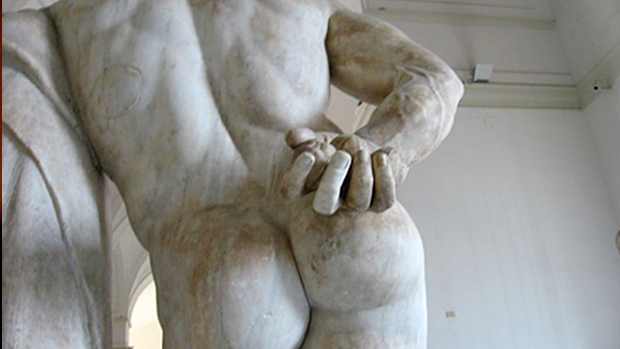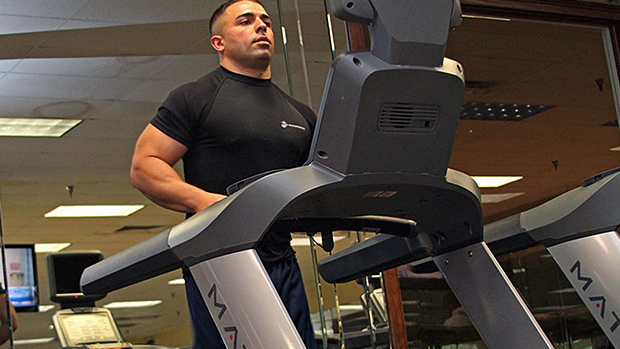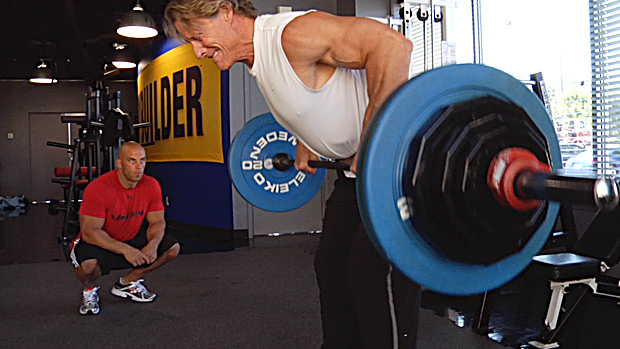It seems every time you pass a newsstand, all the women's fitness mags are having a "special glute edition," but very rarely do you see an article dedicated to glute training for men.
However, the truth is that dedicated glute training can not only do unsexy things like injury prevention, but it can also increase strength and it might just land you a date with the girl you hit on every day by the water cooler.
Injury Prevention
In my personal experience I've found that glute weakness is related to three types of training related injuries. If you're not interested in all the anatomy geek details I've included a non-geek summary at the end of each section to give you a quick breakdown without all of the scientific mumbo jumbo.
1. Knee Pain
The main issue here is that most people have excessively tight hip flexors, particularly the tensor fascia latae (TFL). They also tend to have weak glutes, causing an imbalance at the hip that leads to excessive medial rotation of the femur, lateral tracking of the patella and, most importantly, knee pain.
By strengthening the glutes (particularly the gluteus maximus and the posterior portion of the glute medius), the medial rotation of the hip is corrected and the knee pain will start to disappear. Combine this with some foam rolling of the TFL, IT band, and some stretching of the tight hip flexors and you have a recipe for healthy knees.
Ultimately, complete knee rehab is beyond the scope of this article, but Mike Robertson's Bulletproof Knees program is an excellent resource for those who want more information on this topic.
Non Geek Summary: Foam rolling and stretching of the hip flexors along with strengthening of the glutes leads to healthy, pain-free knees.
2. Lower Back Injury
Technically the glutes and hamstrings are hip extensors and the erector spinae have no direct influence on hip extension. However, when performing a deadlift, all three muscles must act to fully complete the movement. When one muscle (typically the glutes) doesn't function properly the other muscles have to take up the slack.
This is very much like when you were a kid getting assigned to do a group project at school. Invariably there was one guy in the group named Mikey who was too busy picking his nose and eating paste to be bothered so the rest of the group had to do all the work. Fortunately, you could just dunk Mikey's head in a toilet at recess to resolve the issue.
In the case of the deadlift, when the glutes are weak the "locked out" position never truly happens because the hips are never completely extended and the body only reaches the upright position by contraction of the erector spinae and hyperextension of the lower back. In this position the discs of the lower lumbar spine are particularly susceptible to injury.
Non Geek Summary: Strengthening the glutes causes less force to be put on the lower spine during exercises like the deadlift making back injury less likely. If your glutes are weak the next snap, crackle, pop you hear may not be from your child's breakfast cereal.
3. Pulled Hamstrings
By now you should know that sprint type training is superior to endurance type training for fat loss. This is great news for everyone who finds spending an hour on the treadmill as boring as watching Terms of Endearment on a Friday night. Unfortunately, many people trying to take advantage of this type of training experience hamstring pulls from sprinting as a result of having weak glutes.
During a sprinting stride both the glutes and hamstrings assist in propelling the body forward with an explosive extension of the hip joint. However, as mentioned above, when the glutes are weak other muscles have to compensate. In the case of sprinting, the hamstrings are often pulled as a result of trying to make up for the force not being produced by the gluteals.
Non Geek Summary: Weak glutes can lead to hamstring pulls which means your lower body training and interval training will have to take a back seat until you're healed. Strengthen the glutes and this issue can be easily avoided.
Strength
Whether you want to lift heavy to build a muscular physique or just for the sake of throwing heavy shit around, it's absolutely essential to have a strong posterior chain. Essentially, the goal is to have strong muscles from the back of the knees to the back of the neck. If you do this, your squats, deadlifts, snatches, and cleans, will be heavier and your overall strength will explode.
If only one link in that chain is weak, every movement that involves the posterior chain will suffer and your weights will remain wussified for all eternity... or at least until you fix that link. Instead of focusing on the movements you're good at, the best course of action is to identify what is weak and bring it up.
If you're like most people, your glutes are probably the worst offender and by increasing their strength and level of activation your lifts will blow through the roof like the Kool Aid guy smashing through a wall.
Physical Appearance
Now I know everybody here is lifting strictly for health (note the sarcasm), but if you were to consider the effects of glute training on your physique you might like to know that women check out your body, too. In fact, you might also like to know that they don't find it sexy when your ass is so flat that it looks like you just poured pancake batter down the back of your pants.
To make matters worse, having weak glutes leads to a postural fault called anterior pelvic tilt where your lower back is lordodic (hyperextended), making your butt stick out in the back and your stomach stick out in the front.
This is one reason why someone who is relatively lean can actually look like they have a stomach when they actually don't. As sexy as this sounds, I would guess that most women don't dream of a guy that has a stomach he can rest his dinner plate on and a flat butt that sticks out.
Training your glutes can dramatically improve your lordodic posture and give your backside some shape so you don't have to staple your pants to your lower back just to get them to stay up.
The Glute Specialization Routine
The workout below incorporates several exercises that will heavily emphasize the posterior chain to decrease injury risk, make you crazy strong, and build a woman attracting glute max. Several of the exercises are unilateral which will also help you sort out any side to side imbalances you've developed during your usual training program.
I should note that many of these exercises look a lot easier than they actually are. Don't be fooled. If you're doing these right you'll hardly be able to sit on the toilet for the next 5 days.
Foam Rolling
I won't go into too much detail here because this topic has been covered in much more detail HERE. Simply perform some foam rolling on your hip flexors, quads, TFL, and IT Band prior to training. These are probably tight or stiff and will impact your ability to maximally activate your glutes. If you don't have a foam roller yet, get on it!
Mobility Work
The primary goal here is to increase mobility at the hips and ankles prior to lower body work. This also increases muscle temperature and neural drive to the muscles about to be used for training. If you don't recognize any of the drills below I'd highly suggest the Magnificent Mobility DVD.
Ankle Mobility Drill
Front to Back Leg Swings
Side to Side Leg Swings
Knee Hugs
Pull Back Butt Kicks
Walking Spidermans
Glute Activation
If your glutes are underdeveloped, it's imperative you perform some kind of activation work prior to performing this program. The goal here is to simply "awaken" the dormant muscles so we can train them effectively.
The routine is adapted from a program I first saw created by Mike Robertson. It's based on the concept of reciprocal inhibition which means that when one muscle is tight (or contracted), the opposing muscle is shut down. For example, flexing the biceps relaxes the triceps and vice versa. When it comes to the hip joint, tightness in the hip flexors can shut down the glutes so it's imperative that we stretch them prior to activating the glute muscles.
Kneeling Hip Flexor Stretch – Hold for 30 seconds per leg
Make sure to keep the body upright and sink forward until you feel a moderate stretch in the hip of the back leg. Do not place the hands on the front thigh to limit the stretch. Repeat on the opposite leg. With no rest go immediately into the next drill:
Glute Bridge – Perform 10 repetitions
This exercise, affectionately called "sky humps" by one of our clients, is performed by lying on your back and pushing through the feet to raise the hips off the floor until the hip joint is extended.
The key here is to contract the glutes at the top of the movement with very little involvement of the hamstrings. If you feel your hamstrings contracting, try putting your hands on your quads and pushing out slightly through the toes instead of pulling the feet towards you. With no rest go immediately into the next stretch.
Quadruped Piriformis Stretch – Hold for 30 seconds per leg.
I personally like this stretch more than the conventional supine piriformis stretch because it's much easier on the knee joint. To perform the stretch, get on your hands and knees and cross the left ankle behind the right knee. Place the left hand to the outside and lean the body to the left until you feel a stretch in the piriformis. If you don't feel anything try sitting backwards slightly to intensify the stretch. Repeat on the opposite leg. With no rest go immediately into the next drill.
Modified Fire Hydrants - Perform 10 repetitions per leg.
This exercise looks exactly as it sounds. Remain in the quadruped (all fours) position and simply raise the leg out to the side as though you're a dog with a filled-up bladder confronting a fire hydrant.
The key to this exercise is to lead with the knee which will result in a mild degree of external rotation and ensure the activation of the gluteus medius. Be sure that all of the motion occurs at the hip and avoid the temptation to rotate the spine to bring the leg up higher. With no rest go immediately into the next drill.
Glute Alphabet – Perform once with each leg.
While still on the hands and knees, raise one leg straight out behind you. With this foot begin writing the alphabet in the air starting with the letter "A" and try to work your way to the end of the alphabet.
By the time you get half way through the alphabet your glutes should be on fire. You'll probably notice that your hand... errr... footwriting is about as uncoordinated as your drunken uncle Larry after 16 beers, but this won't change the effectiveness of the exercise.
Resistance Training
Single Leg Unsupported Squat
This is probably one of my favorite exercises because conventional single legged exercises (like lunges and Bulgarian squats) just don't engage the gluteus medius to the same degree as unsupported exercises like the single leg squat.
In the unsupported variation, the glute medius has to act to prevent medial rotation of the femur. Since an underactive gluteus medius is typically found in many people who suffer from knee pain, this exercise is a great preventative measure for any trainee.
This exercise is surprisingly difficult and I've had many grown men who can hardly perform the full 3 sets off a 15 inch bench.
Warm Up: 1 set of 5 repetitions per leg
Working Sets: 3
Reps: 5-8 per leg (depending on your level of strength)
Rest Interval: 90 seconds
Notes: Perform the warm up on an 18" bench, box, or platform with no added weight. Perform all working sets on a 15" box while holding a 5 pound dumbbell in each hand.
Believe it or not, this will actually make your balance easier. If you can easily complete all 8 repetitions on the 15" box you should move to a lower platform before trying to increase the weight.
Start with the weaker leg and match the number of repetitions with the stronger leg. If the discrepancy between the legs is large, perform an additional set with the weaker leg only.
Single Leg Romanian Deadlift off Box
I love the conventional single legged Romanian deadlift, but the truth is that most people just can't perform it properly to save their life. They're veering all over the place like Britney Spears escaping rehab.
Instead, I like the off-the-box version because it allows the lifter to regain balance between repetitions and use more weight. It also takes away the ability to use the stretch shortening cycle (the bounce) at the bottom of the movement resulting in greater muscular contraction of the glutes and hamstrings.
To perform this movement you'll need to place two dumbbells on a low box (about 8") or aerobic step. From here you'll bend forward at the hip bringing one leg straight out behind you in line with your body. (It helps to think of a broomstick running from the foot to the back or your head all the way to the ankle.)
From this position, slightly bend the planted leg and grasp the dumbbells. Stand up by strongly contracting the glutes and then drive the hips back as you lower to the starting position to avoid falling forward. Make sure the dumbbells come to a complete stop on the box between reps.
The trailing leg and the body should move as one unit. Personally, I like to think of those drinking bird toys that you can attach to the side of a glass. Balance will be difficult at first, but over the course of a few weeks this movement should become much easier and your weights should increase dramatically.
Working Sets: 4
Reps: 6-8 per leg
Rest Interval: 90 seconds
Notes: As with the single leg squat, make sure to start with your weaker leg. Add a set for that leg if the discrepancy is glaringly obvious. Also, make sure the toes of the trailing leg remain pointed directly at the floor for the whole movement. For most people they tend to turn outward.
Bulgarian Squat
While I thoroughly enjoy watching grown men suffer through the unsupported squat above, the truth remains that you just can't move as much weight in that movement as a supported movement like this one.
To begin the torture session, place the trailing foot on the bench and assume a long lunge position. While maintaining a completely upright position, squat down until the rear knee almost touches the floor and return to the start position. Try holding dumbbells in each hand to make the movement more difficult.
Working Sets: 3
Reps: 12 per leg
Rest Interval: 90 seconds
Notes: If you have a tight rectus femoris on your rear leg, you might find it very difficult to reach the bottom position without bending forward. If this is the case you need to perform stretching and foam rolling to that area to get that sorted out. As with the exercises above, always start with the weaker leg.
Squats
We all know by now that unilateral movements have several advantages like ironing out side to side imbalances and increasing proprioception, but they'll never match bilateral movements in terms of absolute weight lifted, which is essential for strength and hypertrophy.
To ensure that this movement fully targets the glutes, it's imperative that you descend all the way past parallel to bring the glutes and hamstrings into play. The deeper you can go (without flexion of the lumbar spine), the better. In fact, in this particular workout you'll be spending a whole lot of time near the bottom position as you'll be using 1 and 1/2's to make the sure glutes are truly being targeted.
To perform this movement you'll lower to the bottom of the squat, come half way up, return to the bottom, and finally come all the way up. That counts as one rep. Avoid bouncing at the bottom.
Working Sets: 4
Reps: 8-10
Special Technique: 1 and 1/2's
Rest Interval: 90 seconds
Notes: On the final set complete all 1 and 1/2's and then immediately perform as many normal repetitions as possible being sure to go all the way down on each rep.
Wrap Up
After this seemingly straightforward workout your glutes will be so sore you may have to sit on an inflatable ring for the next week. On the plus side, you'll be stronger, less prone to injuries, and a whole lot sexier to the ladies once you train that rump. Just don't let me see you dancing around at your best friend's wedding to Baby Got Back.





